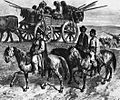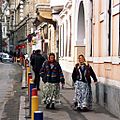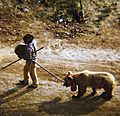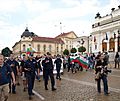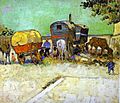Gypsy facts for kids
Gypsy may mean:
- Roma people, is a group of people of Indian origin who once came to Egypt and move later to Europe, often living in caravans. More generally, anyone who moves around often. In some circumstances, calling a person a Gypsy might be considered offensive. The groups of people include,
- the Sinti, also a Romani people, mostly living in central Europe.
- Roma in Turkey/Romanlar
- Gitanos (Spanish gypsies) who speak Caló
- "Travellers" found mainly in Great Britain, Ireland and the United States; and
- In music:
- The Gypsy Kings, a musical group of the 1980s that plays a pop-oriented version of traditional flamenco music (Not to be confused with Ricky Jevon, King of the Gypsies)
- Gypsy and the Haylocks, a reggae folk band who were deemed to be the first band to mix both genres in the 1970s. Traditionally from the Cambridgeshire area they were fronted by Oliver Haylock and his half sister Emmly. (Emmly is the cousin of Bubbler Ranx famous for singing on Peter Andre's Mysterious Girl)
- Gypsy, a song by Fleetwood Mac
- Gypsy, a song by The Moody Blues
- Gypsy: A Musical Fable, a musical inspired by the life of Gypsy Rose Lee
In fiction:
- Gypsy, a robot character from the TV series Mystery Science Theater 3000
- Gypsy, a fictional character from DC Comics
- Gypsy Moth, a fictional mutant character from Marvel Comics
Other meanings:
- Gypsy, West Virginia, USA
- Gypsy moth, a destructive insect that causes trees to lose their leaves
- Gypsy (software), the first modern document preparation system
- Winston "Gypsy" Peters, a Trinidad and Tobago politician and calypsonian
- A "gypsy" is a part on a boat windlass designed to haul chain. It may have a groove to enable it to haul rope and chain when it is called a combined gypsy and capstan
- Gypsy (elephant) is the name of an elephant given to Michael Jackson by Elizabeth Taylor
- The J/ψ particle, a subatomic particle
Images for kids
-
Three Finnish Romani women in Helsinki, Finland, in 1930s
-
Gypsies camping. Welsh Romanies near Swansea, 1953
-
Two Gypsies by Francisco Iturrino
-
A Roma makes a complaint to a local magistrate in Hungary, by Sándor Bihari, 1886
-
An 1852 Wallachian poster advertising an auction of Romani slaves in Bucharest
-
Sinti and other Romani about to be deported from Germany, 22 May 1940
-
Münster, Sebastian (1552), "A Gipsy Family", The Cosmographia (facsimile of a woodcut), Basle
-
Nomadic Roma family traveling in Moldavia, 1837
-
Christian Romanies during the pilgrimage to Saintes-Maries-de-la-Mer in France, 1980s
-
Two Orthodox Christian Romanies in Cluj-Napoca, Romania
-
Romani and bear (Belgrade, Banovo brdo, 1980s)
-
Gypsy fortune-teller in Poland, by Antoni Kozakiewicz, 1884
-
Muslim Romanies in Bosnia and Herzegovina (around 1900)
-
Street performance during the Khamoro World Roma Festival in Prague, 2007
-
Deportation of Roma from Asperg, Germany, 1940 (photograph by the Rassenhygienische Forschungsstelle)
-
Distribution of the Romani people in Europe (2007 Council of Europe "average estimates", totalling 9.8 million)
-
Antiziganist protests in Sofia, 2011
-
Paris Bordone, The Rest on the Flight into Egypt c. 1530, Elizabeth, at right, is shown as a Romani fortune-teller
-
August von Pettenkofen: Gypsy Children (1885), Hermitage Museum
-
Vincent van Gogh: The Caravans – Gypsy Camp near Arles (1888, oil on canvas)
See also
 In Spanish: Pueblo gitano para niños
In Spanish: Pueblo gitano para niños












